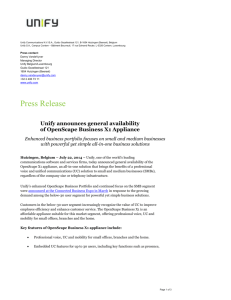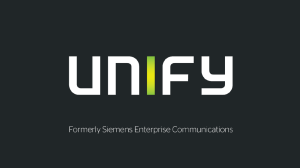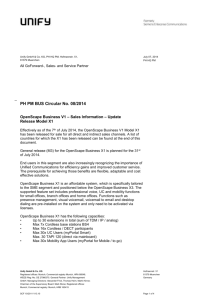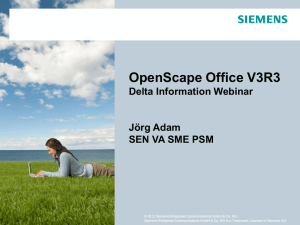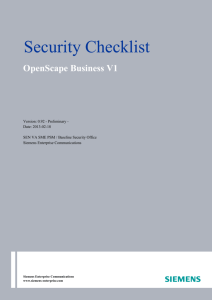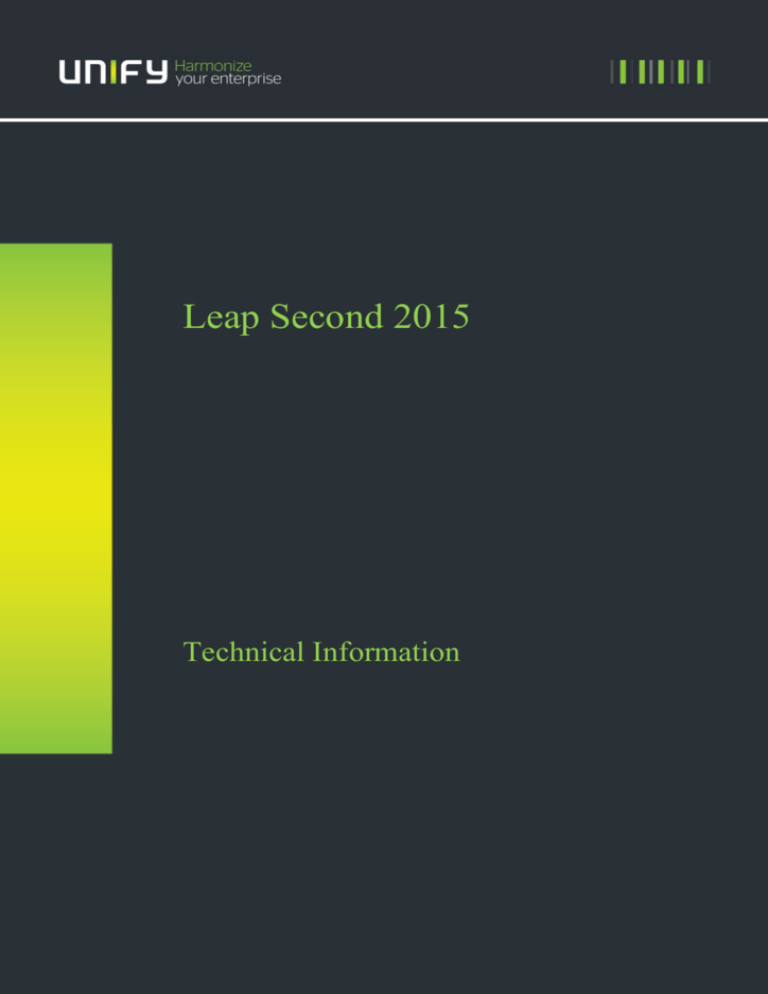
Leap Second 2015
Technical Information
2
Table of Contents
Contents
1.
Document Information .............................................................................................................................. 3
1.1. Purpose of the Document .................................................................................................................. 3
1.2. Author of the Document .................................................................................................................... 3
1.3. Accompanying Documents................................................................................................................ 3
1.4. External References ........................................................................................................................... 3
2. Procedure .................................................................................................................................................. 3
2.1. Purpose .............................................................................................................................................. 4
2.2. Identification...................................................................................................................................... 4
2.3. Scope ................................................................................................................................................. 5
2.3.1.
Vulnerable Products .................................................................................................................. 5
2.3.2.
Not Vulnerable Products ........................................................................................................... 5
2.4. Risk of Not Taking Any Action ........................................................................................................ 6
2.5. July 1st Emergency Support ............................................................................................................... 6
3. Resolution ................................................................................................................................................. 8
3.1. SME ................................................................................................................................................... 8
3.1.2.
Solution...................................................................................................................................... 8
3.2. HiPath 4000 V6 R1 - OpenScape 4000 V7 R1................................................................................ 10
3.2.1.
Risk .......................................................................................................................................... 10
3.2.2.
Solution 1................................................................................................................................. 10
3.2.3.
Solution 2................................................................................................................................. 10
3.3. OpenScape 4000 Manager V7 ......................................................................................................... 12
3.3.1.
Risk .......................................................................................................................................... 12
3.3.2.
Solution 1................................................................................................................................. 12
3.3.3.
Solution 2................................................................................................................................. 13
3.4. Call Director Sip Service (CDSS) ................................................................................................... 14
3.4.1.
Risk .......................................................................................................................................... 14
3.4.2.
Time Estimation ...................................................................................................................... 14
3.4.3.
Procedure Description ............................................................................................................. 14
3.5. OpenScape Voice V7R1 – V8 ......................................................................................................... 16
3.5.1.
Risk .......................................................................................................................................... 16
3.5.2.
Solution 1................................................................................................................................. 16
3.5.3.
Solution 2................................................................................................................................. 16
3.6. Applications ..................................................................................................................................... 18
3.6.1.
Risk .......................................................................................................................................... 18
3.6.2.
Solution 1................................................................................................................................. 18
3.6.3.
Solution 2................................................................................................................................. 19
4. Appendix................................................................................................................................................. 21
4.1. Glossary ........................................................................................................................................... 21
UNIFY SA
3
1. Document Information
1.1.
Purpose of the Document
This document is delivered for the Leap Second issue that was announced for June 30th 2015
and contains information, instructions and recommended actions for all Unify products.
The announcement was made from Earth Orientation Center of IERS Observatoire de Paris, France (See Chapter 1.6).
1.2.
Author of the Document
Copyright © UNIFY SA
Author:
Name:
T. Aravopoulos
1.3.
Accompanying Documents
Document Title
OBSO-1505-01
Author
OpenScape Baseline
Security Office
obso@unify.com
© Unify GmbH & Co KG
2015
Hofmannstr. 63, D81379 München
Reference
Security Advisory Report – OBSO (Leap
Second on 2015-06-30 - Security Note
for Unify Products)
www.unify.com
1.4.
External References
Information about Leap Second Issue by Suse can be found here:
https://www.suse.com/communities/conversations/2015-leap-second-know and
https://www.suse.com/support/kb/doc.php?id=7016150
Leap Second announcement: http://hpiers.obspm.fr/eoppc/bul/bulc/bulletinc.dat
2. Procedure
UNIFY SA
4
2.1.
Purpose
A leap second is a one-second adjustment that is occasionally applied to Coordinated Universal Time (UTC) in order to
keep its time of day close to the mean solar time, or UT1. Without such a correction, time reckoned by Earth's
rotation drifts away from atomic time because of irregularities in the Earth's rate of rotation. Since this system of
correction was implemented in 1972, 26 such leap seconds have been inserted. The most recent one happened on June
30, 2012 at 23:59:60 UTC. A leap second will again be inserted at the end of June 30, 2015 at 23:59:60 UTC
There is a leap second being added at midnight on June 30th 2015 (the “2015 Leap Second”). In the past, Linux based
systems have had some issues handling the introduction of a leap second and these have led to the operating system
becoming deadlocked and affecting server operation. The Linux maintainers have provided operating system updates
(kernel) to address these. A certain number of products delivered by Unify are running on the vulnerable Operating
System SLES11.
General Note: Only products/servers running on SLES11 connected to an NTP (standard deployment according OSRA)
may be vulnerable! (Note that Linux X86 architecture based kernels of multiple Linux operating systems are vulnerable.
Some of those non-SLES based Linux distributions are used in Unify embedded platforms (e.g. OpenScape Office MX /
OpenScape Business X embedded).
The overall risk for potential system outages or service interruptions in Unify products is rated as low.
2.2.
Indemnification
PLEASE NOTE: it is the customer’s responsibility to ensure that the following instructions have been actioned
in good time before 30 June 2015, where relevant. Unify shall have no liability for any losses, expenses, claims or
damages, whether direct or indirect, in the contemplation of the parties or otherwise, which are sustained by the
customer, partner or any third party as a result of the 2015 Leap Second or any failure of technology to function
correctly by reason of the 2015 Leap Second, if the customer has not actioned the instructions below within a
reasonable time before 30 June 2015. Whilst Unify has used reasonable endeavors to ensure that the instructions
below will not have an adverse impact on the rest of the customer’s systems and network, the customer is
responsible for taking all reasonable precautions to minimize any such adverse impact.
Unify Partner is responsible for bringing the above notice to the attention of the customer in writing.
To identify if a SLES11 system is vulnerable, proceed as described as follows:
1.
2.
Login to system via command line.
Execute the following command:
# uname -a
Example:
If the kernel is below the ones mentioned here, the system is vulnerable to incorrect behavior after the leap second
is added.
SP1 - kernel 2.6.32.59-0.19.1 was released mid of April 2015
SP2 - kernel 3.0.101-0.7.29.1 was released end of March 2015
SP3 - kernel 3.0.101-0.47.52.1 was released end of March 2015
UNIFY SA
5
2.3.
Scope
Below is a complete list of vulnerable and NOT vulnerable products:
2.3.1. Vulnerable Products
For each vulnerable product listed below, please follow the instructions at the corresponding chapter. In these chapters
possible impacts, risk and mitigation are detailed.
Vulnerable Product
Section of current Doc
OpenScape Business V1 S (server based variant)/ Booster
Server V1
OpenScape Office V3R3.x, LX / HX (server based
variants)
OpenScape Office MX V3R3.x
See Chapter 3.1
OpenScape Business X [embedded variants]
See Chapter 3.1
HiPath 4000 V6 R1 Platform & Softgate (older versions
than R1.12.2)
OpenScape 4000 V7 R1 Platform and Softgate before V7
R1.8.3 or V7 R1.39.1
OpenScape 4000 Manager (running on SLES11SP3 64bit)
See Chapter 3.2
Call Director Sip Service (running on OpenSuse 11.1 - all
versions up to and including V8 R2)
OpenScape Voice V7R1 & V8.xx (OpenScape Voice V7 R1
before V7 R1.43.1, OpenScape Voice V8 before V8
R0.34.7)
OpenScape Fault Management
OpenScape UC Servers (BE, FE & MS) (V7 & V6 running
SLES 11)
OpenScape Voice Survivability Authority
OpenScape Façade Server (running SLES 11)
OpenScape OpenFire (running SLES 11)
OpenScape Google App Server (running SLES 11)
See Chapter 3.4
See Chapter 3.1
See Chapter 3.1
See Chapter 3.3
See Chapter 3.5
See Chapter 3.6
See Chapter 3.6
See Chapter 3.6
See Chapter 3.6
See Chapter 3.6
See Chapter 3.6
2.3.2. Not Vulnerable Products
NOT Vulnerable Product
Unify products running on
Microsoft Windows operating
systems
OpenStage / OpenScape Desk
Phone IP
HiPath3000
HiPath/OpenScape 4000 Assistant
& CSTA (all versions)
HiPath Cordless IP
OpenScape Alarm Response
(OScAR) Eco & Pro
Comments
not vulnerable
not vulnerable
not vulnerable
not vulnerable
not vulnerable
not vulnerable
UNIFY SA
6
HiPath 4000 V6 R2 and OpenScape
4000 V7 R0 Platform and Softgate
Already include the required fixes
HiPath 4000 V5 and earlier
not vulnerable
HiPath 4000 Manager
not vulnerable (running on SLES10SP4 32bit)
OpenScape Contact Center
not vulnerable (running on Windows server 2003/2008)
Products use updated kernels
OpenScape Session Border
Controller or OpenScape Branch
OpenScape Xpert
Debian versions are not vulnerable
OpenScape Xpressions
not vulnerable
OpenScape Fast Viewer
not vulnerable
not vulnerable (running on SLES10)
not vulnerable
QCU (QoS Data Collection Unit):
Applications running on Linux
systems other than Novell SLES
(e.g. Novell SLES 10, or Debian
Linux V6 or V7 for OpenScape
Xpert MLC
Each procedure/solution is marked to indicate the perceived risk associated with the procedure
Low Risk
2.4.
Medium Risk
High Risk
Risk of Not Taking Any Action
If a product is listed in the above tables as being vulnerable to the insertion of the leap second, it is strongly
recommended that the preventive measures listed in this document are applied proactively.
Without protection, it is possible that one or more processes within the operating system may freeze or
otherwise become corrupted and affect the operation of the system. Typically a full system restart will
restore the correct operation.
If a system cannot be protected prior to June 30th, it is strongly recommended that a full system backup be
taken as a precaution.
2.5.
July 1st Emergency Support
If a system is not operating correctly following the leap second period, regardless of whether it is
protected or not, the following steps should be followed:
1) Conduct a full system restart
UNIFY SA
7
2) Submit a service ticket via your usual support channel. Partners with service rights may open
tickets directly with Unify, or in case of priority 1 incidents, contact the expert assistance hotline.
Partners that receive services through the distribution channel should reach out for support
through their respective distributor.
UNIFY SA
8
3. Resolution
3.1.
SME
3.1.1.1.1.
Risk
The corresponding risk was evaluated to Low
3.1.2. Solution
3.1.2.1.1.
Time Estimation
The estimated time is calculated to: 45 Minutes, and is dependent on the speed of the server/internet connection.
3.1.2.1.2.
Impact
In case a system software update is required, there will be a downtime due to the system restart.
3.1.2.1.3.
Procedure Description
The systems that could be vulnerable to the time adjustment are the server based variants (OpenScape Business
S, Booster Server V1 and OpenScape Office LX/HX V3 R3.x) running on SLES11.x and connected to an NTP
server and OpenScape Business X embedded variants, OpenScape Office MX V3 R3.x connected to an NTP
server.
To ensure no issues are encountered when the time adjustment will be made, some precautionary measures can
be implemented. Please be aware that the update of the operating system is the responsibility of
service/customer.
OpenScape Business S, Booster Server V1 [server based variant]:
1.
Perform a software update to OpenScape Business S V1R3.0.0 or later version (latest General
Available Software recommended) – mandatory
2.
A SLES operating system update is allowed to be applied according to the Service Pack used
(please check and proceed as explained in
Chapter 3.6.1.2) – mandatory
OpenScape Office LX/HX V3R3.x [server based variant]:
1.
Perform a software update to OpenScape Office V3R3.10.0 or later version (latest General
Available Software recommended) – mandatory
2.
A SLES operating system update is allowed to be applied according to the Service Pack (please
check and proceed as explained in
Chapter 3.6.1.2) – mandatory
OpenScape Business X embedded variants and OpenScape Office MX V3R3.x:
UNIFY SA
9
For OpenScape Business and OpenScape Office embedded variants the NTP configuration should be
temporarily deactivated by June 29, 2015 23:00:00 UTC at the latest and can be reactivated after July 1,
2015 00:00:01 UTC. The deactivation of the NTP synchronization for a few days does not have any impact
on the stability of the system.
To deactivate the NTP configuration, please go to the WBM of the system to Expert Mode/Telephony
Server/Basic Settings/Date and Time/SNTP Settings and from the dropdown of the field “Administration
Mode of SNTP Client:” choose the option “down” and select “Apply”.
To reactivate the NTP configuration, follow the same path in WBM, Expert Mode/Telephony Server/Basic
Settings/Date and Time/SNTP Settings and from the dropdown of the field “Administration Mode of SNTP
Client:” choose the option “up” and select “Apply”.
UNIFY SA
10
3.2.
HiPath 4000 V6 R1 - OpenScape 4000 V7 R1
For the HiPath 4000 V6 R1 and OpenScape 4000 V7 R1 there are two options for implementation.
3.2.1. Risk
The corresponding risk for versions before HiPath 4000 V6 R1 was evaluated to High
The corresponding risk for OpenScape 4000 V7 R1 was evaluated to Low
3.2.2. Solution 1
Applying the patch of exchanging ntp-daemon.
The described fix is without downtime and can be applied to the following systems:
- HiPath 4000 V6 R1 systems (including Standalone SoftGates)
- OpenScape 4000 V7 R1.8 systems (including Standalone SoftGates)
- OpenScape 4000 V7 R1.39 systems (including Standalone SoftGates)
3.2.2.1.1.
Time Estimation
The estimated time to complete this procedure is calculated to: 10 minutes
3.2.2.1.2.
Procedure Description
The fix is without downtime and must be applied to every node in the system.
This applied patch is not further distributed by APE HBR or RAR.
Subsequent official Hotfixes can be activated on top of this fix without issue.
The complete procedure description the corresponding RPM’s can be found at the INF-15-000243, located in
the Service Info section of the partner portal.
3.2.3. Solution 2
Perform an Upgrade
Official Hotfixes are or will be available as described in INF-15-000243, located in the Service Info section of
the partner portal.
3.2.3.1.1.
Time Estimation
Platform Hotfix HiPath 4000 V6 R1.12.2 (HF003013)
Complete upgrade duration depends on the actual deployment, hardware and base PLT version, however the
available average durations are as follows:
Simplex deployment
~30 minutes
Duplex deployment
~1 hour
GeoSeparated Duplex
~1 hour
UNIFY SA
11
APE deployments
~30 minutes (via AP Host backup & APE restore)
3.2.3.1.2.
Impact
Platform Hotfix HiPath 4000 V6 R1.12.2 (HF003013)
PLT-HF V6 R1.12.2 is a type 2 hotfix with following impact:
Simplex deployments:
telephony/application downtime due to node reboot
Duplex deployments:
no telephony downtime but CC/ADP switchovers (CSTA down) due to
sequential node reboots.
Note that the PLT-HF V6 R1.12.2 is not available for Standalone Softgates; there, use Solution 1 in any
case
3.2.3.1.3.
Procedure Description
Upgrade to V6 R1.12.2 (HF003013)
The precondition for the activation of a PLT-Hotfix is the V6 R1.12.0.
Note: Upgrade from V6R1.9.0, V6 R1.10.0 to V6 R1.12.0 is possible.
For more details see the “Service Documentation” located in the Portfolio Information section in the partner
portal.
The PLT-Hotfix is transferred by means of SWT and activated using SWA.
Detailed information on handling the SWT and SWA is contained in the following manuals:
HiPath 4000 V6, Section 3 - Feature Usage Examples, Service Documentation, Issue X, Chapter
13 (Software Update of HiPath 4000 Systems) - Link
HiPath 4000 Assistant/Manager V6, Software Transfer 2, Administrator Documentation, Issue
X - Link
UNIFY SA
12
3.3.
OpenScape 4000 Manager V7
3.3.1. Risk
The corresponding risk was evaluated to Low
3.3.2. Solution 1
Kernel Update
3.3.2.1.1.
Time Estimation
The estimated time to complete this procedure is calculated to: 45 Minutes.
3.3.2.1.2.
Impact
This is a permanent solution, so no other actions will need to be performed once the updated kernel is installed.
The system will need rebooting, in order to start using the new kernel, so there will be a disruption of service
until the system comes back up.
3.3.2.1.3.
Procedure Description
The recommended patch must be downloaded from Novell’s web site. Novell’s Patch Finder can be reached
via the following link:
http://download.novell.com/patch/finder/#bu=suse&familyId=7261&productId=&dateRange=&startD
ate=&endDate=&priority=&architecture=&keywords=&xf=7261&xp=7261_50884
o
o
Only 64 bit architecture (x86_64) SLES 11 SP3 operating system is supported in
V7R0 (and up)
For SLES 11 SP3 (x86_64) the required patch is Linux Kernel 10546.
To obtain a patch from the website, the technician performing the download will need to have a login account
supporting patch downloads (for SLES11 SP3 the account will additionally need Long Term Service Pack
Support [LTSS] privileges).
Once the latest kernel updates are downloaded, they must be transferred onto the SLES 11 system requiring the
update. On the SLES11 system create a new directory (for example /patches) and upload the RPMs into that
directory.
Once all the RPMs are on the system, as user root, start “yast” from the command line:
yast
And perform the following actions:
Software -> Software Repositories -> Add -> Local Directory -> set path to directory containing RPMs
-> OK to save configuration and addition of repository -> go to main screen and exit yast.
From the command line check that the repository has been added by executing the command:
UNIFY SA
13
zypper sl
The output should include the directory where the new RPMs have been stored.
The next step is to start the update procedure, by entering the command:
zypper up -t package
This should take approximately 5 minutes, and once complete the system will be updated with the new kernel.
In order for the system to start running with the new kernel, it will need to be rebooted with the following
command:
init 6
Once the system comes back up, check the kernel version by executing:
uname –r
It should display the following:
3.0.101-0.47.52-default
3.3.3. Solution 2
The workaround ("slew mode") described by Novell is not applicable on OpenScape 4000 Manager Servers (as a
different NTP configuration interface is implemented). An alternate option (for unpatched installations with
high availability requirements) is temporarily to disable the NTP daemon via webmin on June 29th UTC and
enable it again not before July 1st, 01:00 am UTC.
3.3.3.1.1.
Time Estimation
The estimated time to complete this procedure is calculated to: 15 Minutes.
3.3.3.1.2.
Impact
No system downtime and small overall implementation time.
3.3.3.1.3.
Procedure Description
Disable the NTP daemon via webmin on 29th June UTC and enable it again after 1st July 01:00 AM UTC or
later. To do so, logon to OpenScape 4000 Manager, go to Base Administration – Webmin –
Date/Time . Click on Ext. Time Server link and, from the dropdown list on the right side, you can
switch between External (via NTP) and Local (HW Clock) then click on Modify button, to save
the changes.
UNIFY SA
14
3.4.
Call Director Sip Service (CDSS)
NTP Server Restart
3.4.1. Risk
The corresponding risk was evaluated to Low
3.4.2. Time Estimation
The estimated time to complete this procedure is calculated to: 10 Minutes.
3.4.3. Procedure Description
The Call Director SIP Server is discussed in this document as the underlying OS platform of this product
(openSUSE11.1 with kernel 2.6.27.56) is listed as potentially affected.
Customers with a CDSS server installed, however, are not expected to face any issues due to the nature of
message processing employed by the solution. All CDSS messages are processed sequentially rather than
synchronously with any external party. The leap second issue is also not valid if there is no NTP service running.
The developers of the CDSS have evaluated the risk to CDSS installations have decided that no fix is required,
indeed it is not possible either due to the version of OpenSuse currently used by CDSS. This position is also
based on the lack of any reported issues across the global CDSS customer base during the last such occurrence
of a leap second back in June 2012.
However, to guard against the minimal risk discussed, customers can, at their discretion, stop the NTP service
temporarily and start it again once the leap second has occurred. This has been tested and can be done in the
following way:
From the OSCC or another service through which the CDSS machine can be reached, establish a secure
connection using Putty. Please ensure this is installed on the machine from which you will be accessing the
CDSS ahead of the work. Use the credentials of user “root” to connect.
Once connected, verify if the NTP service is running. From the root prompt, execute the command:
ps -ef
If the service is running you will see an entry in the list produced for service name “NTP” and a reference to the
process “NTPD”. If this does not appear in the list produced, the NTP service is not running and no further
action is required.
If the “NTP” service is listed, to stop the service, execute the command:
service ntp stop
The successful stopping of this service will be confirmed by the result “ done” in green font.
From the main prompt, you can then exit the session by typing:
exit
UNIFY SA
15
At the time chosen to restart the NTP service, connect to the OS interface of the CDSS in the same manner and
execute the command:
service ntp start
Again this will be confirmed. You can then list the running services in the same way as before to verify it is
running using:
ps -ef
Again, exit in the same manner as previously noted.
The running of the CDSS service is not affected during this change.
UNIFY SA
16
3.5.
OpenScape Voice V7R1 – V8
3.5.1. Risk
The corresponding risk was evaluated to Low
3.5.2. Solution 1
Binary Installation
3.5.2.1.1.
Time Estimation
The estimated time to complete this procedure is calculated to: 10 Minutes
3.5.2.1.2.
Impact
No system downtime and a brief overall implementation time. This is not a permanent solution though, and the
kernel will need to be updated at some point in order to obtain the actual fix.
3.5.2.1.3.
Procedure Description
On the OSV server, the NTP operation will be changed to operate over the leap second period in slew mode. The
change will be performed via a binary that has been provided by development.
The installation of the provided binary must be performed BEFORE 23:00:00 UTC June 29th 2015.
As user root, download the binary leap_sec.2015.bin onto the OSV server, (e.g.
/export/home/units/leap_sec.2015.bin).
The solution and the steps required to apply it, are available as Service Information INF-15-000236, located in
the Service Info section of the partner portal.
3.5.3. Solution 2
OSV Image Installation
3.5.3.1.1.
Time Estimation
The estimated time to complete this procedure is calculated to: 3 Hours.
3.5.3.1.2.
Impact
This is a permanent solution; no other actions will need to be performed once the updated kernel is installed. The
procedure requires a large maintenance window to be provided in order for the image installation to be
performed.
UNIFY SA
17
3.5.3.1.3.
Procedure Description
Upgrade the OSV to the patch containing the official Linux kernel fix. There are two patches that have been
made available by development:
For V7 - V7 R1.43.1
(Link)
For V8 - V8 R0.34.8
(Link )
Download the appropriate patch from SWS, and perform an upgrade on the system according to the upgrade
procedure outlined in the release notes of each patchset.
(Section 2.2 Upgrade /Update).
Please note that you will need to login to the partner portal to be able to download these files.
UNIFY SA
18
3.6.
Applications
3.6.1. Risk
The corresponding risk was evaluated to Low
Note: In case OSEE (OpenScape Enterprise Express) solution is installed, the solution for OpenScape Voice
should be applied, as described in Chapter 3.5. No further actions are required from Applications perspective.
3.6.2. Solution 1
Novell Fix Installation
3.6.2.1.1.
Time Estimation
The estimated time to complete this procedure is calculated to: 45 Minutes depending on solution.
3.6.2.1.2.
Impact
This is a permanent solution; no other actions will need to be performed once the updated kernel is installed. The
system will require a reboot so there will be a disruption of service while the system comes back up.
3.6.2.1.3.
Procedure Description
The recommended patch, containing the fix for this issue in both SLES11 SP2 and SP3, must be downloaded
from Novell’s web site. Novell’s Patch Finder can be reached via the following link:
http://download.novell.com/patch/finder/#bu=suse&familyId=7261&productId=&dateRange=&startD
ate=&endDate=&priority=&architecture=&keywords=&xf=7261&xp=7261_50884
-
For SLES 11 SP2 the required patch is, depending on the architecture:
o x86 - Linux Kernel 10239
o s390x - Linux Kernel 10245
o x86_64 - Linux Kernel 10246
-
For SLES 11 SP3 the required patch is, depending on the architecture:
o x86 - Linux Kernel 10545
o x86_64 - Linux Kernel 10546
o ppc - Linux Kernel 10547
o s390x - Linux Kernel 10548
To obtain a patch from the website, the technician performing the download will need to have a login account
supporting patch downloads (for SLES11 SP2 the account will additionally need Long Term Service Pack
Support [LTSS] privileges).
UNIFY SA
19
Once the latest kernel updates are downloaded, they must be transferred onto the SLES 11 system requiring the
update. On the SLES11 system create a new directory, for example /patches, and upload the RPMs into that
directory.
Once all the RPMs are on the system, as user root, start “yast” from the command line:
yast
And perform the following actions:
Software -> Software Repositories -> Add -> Local Directory -> set path to directory containing RPMs
-> OK to save configuration and addition of repository -> go to main screen and exit yast.
From the command line check that the repository has been added by executing the command:
zypper sl
The output should include the directory where the new RPMs have been stored.
The next step is to start the update procedure, by entering the command:
zypper up -t package
This should take approximately 5 minutes, and once complete the system will be updated with the new kernel.
In order for the system to start running with the new kernel, it will need to be rebooted with the following
command:
init 6
Once the system comes back up, check the kernel version by executing:
uname –r
It should display the following:
3.0.101-0.47.52-default
3.6.3. Solution 2
NTP Server Restart
3.6.3.1.1.
Time Estimation
The estimated time to complete this procedure is calculated to: 15 Minutes.
3.6.3.1.2.
Impact
No system downtime and a brief overall implementation time. This is not a permanent solution though, and the
kernel will need to be updated at some point in order to obtain the actual fix.
3.6.3.1.3.
Procedure Description
This solution provides a work around which will allow the system to continue working without disruption, and
still be unaffected by the leap second issue.
UNIFY SA
20
The execution of the provided script must be performed BEFORE 23:00:00 UTC June 29th 2015. The script
stops the NTP server two minutes prior the leap second event and starts it two minutes after.
Copy the leapFix.sh script into the SLES machine, in the /root directory. The script is enclosed:
As user root, change its rights with the following command:
chmod 750 leapFix.sh
Again as user root, execute the script:
/root/leapFix.sh
Check crontab to verify that the two new entries have been added. In order to achieve this, execute the following
command:
crontab -l
This will output the root user's crotab, and should contain the following two lines:
58 23 30 06 * /sbin/service ntp stop; /usr/sbin/ntptime -s 0
02 00 01 07 * /sbin/service ntp start
Note that the time and date displayed for each cronjob will depend on the time zone that the system is located.
So the above example will be displayed on systems located in UTC +00:00 time zones.
In order to remove the two added entries (any time after 00:02 01/07), as root user, execute the following:
/root/leapFix.sh –remove
Lastly proceed to deleting the script from the system:
rm /root/leapFix.sh
UNIFY SA
21
4. Appendix
4.1.
Abbreviation
CDSS
CFB
CFNR
CFU
CLIP
CLIR
CM
CMP
DB
DHCP
DLS
DNS
DNS SRV
DTMF
EthX
GUI
IP
ISDN
ITIL
IVR
LAN
MDX
MLHG
MoH
MS
N/A
NTP
ODC
OSB
PnP
PSTN
RM
RNA
RTP
RTP/AVP
SDP
SIP
SIPSM
SSH
UC
Glossary
Explanation
Call Director Sip Service
Call Forward Busy
Call Forward No Reply
Call Forward Unconditional
Calling Line Identification Presentation
Calling Line Identification Restriction
Change Manager
Common Management Portal
Database
Dynamic Host Configuration Protocol
Deployment Service
Domain Name System
Domain Name System (Service) Resource Records
Dual-Tone Multi-Frequency signaling
Ethernet Device X
Graphical User Interface
Internet Protocol
Integrated Services Digital Network
Information Technology Infrastructure library
Interactive Voice Response
Local Area Network
Mediatrix gateway
Multi Line Hunt Group
Music on Hold
Media Server
Not Applicable
Network Time Protocol
Openscape Desktop Client
Openscape Branch
Plug and play
Public switched telephone network
Release Manager
Release No Answer
Resilient Telco Platform or Real-time Transport Protocol
Real-time Transport Protocol / Audio Video Profile
Session Description Protocol
Session Initiation protocol
SIP Signaling Manager
Secure Shell
Unified Communications
UNIFY SA
22
WBM
XPR
Web based management
Openscape Xpressions Server
UNIFY SA
23
About Unify
Unify is one of the world’s leading communications software and services firms, providing integrated communications solutions for
approximately 75 percent of the Fortune Global 500. Our solutions unify multiple networks, devices and applications into one easy-to-use
platform that allows teams to engage in rich and meaningful conversations. The result
is a transformation of how the enterprise communicates and collaborates that amplifies collective effort, energizes the business, and
enhances business performance. Unify has a strong heritage of product reliability, innovation, open
standards and security.
Unify.com
Copyright © Unify GmbH & Co. KG, 2015
Hofmannstr. 63, D-81379 Munich, Germany
All rights reserved.
The information provided in this document contains merely general descriptions or characteristics of
performance which in case of actual use do not always apply as described or which may change as a result
of further development of the products. An obligation to provide the respective characteristics shall only
exist if expressly agreed in the terms of contract. Availability and technical specifications are subject to
change without notice.
Unify, OpenScape, OpenStage and HiPath are registered trademarks of Unify GmbH & Co. KG.
All other company, brand, product and service names are trademarks or registered trademarks of their
respective holders.

